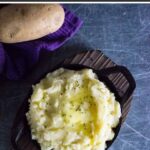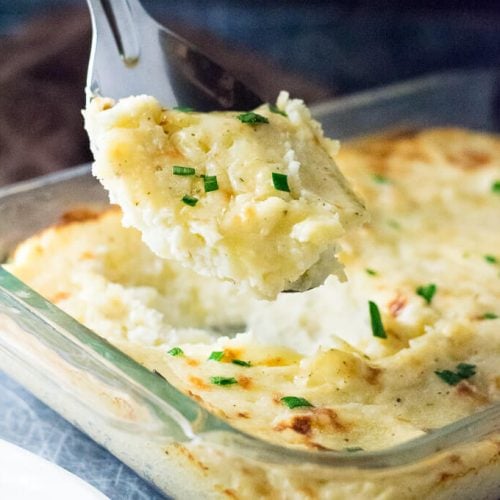Can you make fluffy mashed potatoes without milk? Yes, you absolutely can! Whether you just ran out of milk, or need to make this a dairy-free side dish, let me show you the best options and substitutions.

What can I substitute for milk in mashed potatoes?
The best mashed potatoes require liquid to lighten their texture and add moisture. You can make mashed potatoes without any added liquid, but they won't be very light and fluffy. Instead, I recommend using one of these easy substitutions in place of milk.
- Vegetable broth - Vegetable stock is an equally good substitute as well. Same with chicken broth. Using vegetable broth or stock is the best substitute because it adds a rich flavor and moisture, making it my favorite substitution.
- Potato boiling water - Reusing the starchy cooking water from boiling your potatoes is a great way to add moisture to mashed potatoes.
- Non-dairy milk - If you have a dairy restriction you can use any non-dairy alternative such as soy milk.
- Heavy cream - Heavy cream is the secret ingredient for creating the creamiest mashed potatoes and is the best dairy substitution I recommend. However, be aware it is obviously made with dairy.
Ingredients and Substitutions
- Russet potatoes - For the fluffiest mashed potatoes, I strongly recommend starchy potatoes like russets over waxy Yukon gold potatoes. I recommend checking out my Steakhouse mashed potato recipe if you wish to use other types of potatoes like Yukons or red potatoes.
- Vegetable broth - Either broth or stock is a good choice.
- Butter - Use a non-dairy butter substitute if you need to make this dish dairy-free. Olive oil can also work, but butter is much better.
Optional: You can add extra flavor to this easy recipe by adding minced garlic cloves, sour cream, or fresh herbs such as thyme. Sometimes I even add a bay leaf to the boiling water.

How to make it
The best way I have found to make consistently great mashed potatoes is to chop them into one-inch chunks add start them in a pot of cold salted water. Cover the pot with a lid and set it over high heat to bring to a boil, then once it is boiling set the timer for 15 minutes. You can reduce the burner to medium heat if needed to control the boil.
Your potatoes should be perfectly tender now. Drain the hot potatoes from the water and place them in a large bowl. The best way to mash potatoes for a creamy texture is using a potato ricer or food mill. However, if you like your mashed potatoes a little chunkier, just use a potato masher instead.
Tip: Avoid using a hand mixer, or any electric mixers, as it will make your mashed potatoes gummy by overworking them.
You can now fold in the broth, butter, salt, and pepper with a spatula. Work it in until it is well combined, but be careful not to overmix everything or the potatoes can turn gluey. Top with additional melted butter, if desired, and serve immediately.

Storing & Reheating Leftovers
Leftover mashed potatoes should be stored in an airtight container in your refrigerator and enjoyed within five days. The leftovers can be reheated easily in a microwave. If they taste drier, you can add a little more liquid to rehydrate them back to their former glory. The leftovers also work really well to repurpose as a super easy 4 ingredient potato soup.
More Mashed Potato Recipes

Mashed Potatoes without Milk
Equipment
Ingredients
- 2 pounds russet potatoes peeled and cut into 1" chunks
- ¼ cup vegetable broth
- 4 tablespoon butter or non-dairy butter substitute
- 2 teaspoons table salt
- ½ teaspoon freshly ground black pepper
Instructions
- Add chopped potatoes to a large pot of salted cold water. Cover with a lid and set over high heat on the stovetop and bring to a boil. Boil potatoes for 15 minutes.
- Once tender, and easily pierced with a fork, drain cooked potatoes from water and place in a large bowl.
- Add vegetable broth, butter, salt, and black pepper and mash to combine.
- Alternatively, for smoother mashed potatoes run them through a food mill or ricer, and then use a spatula to fold together with butter and seasonings.
Notes
Nutritional Information
This recipe was originally published on April 29, 2022.







Leave a Reply